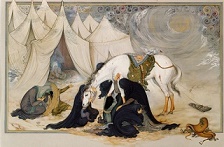Marthiya: Difference between revisions
No edit summary |
No edit summary |
||
| (2 intermediate revisions by the same user not shown) | |||
| Line 1: | Line 1: | ||
{{Mourning of Muharram-vertical}} | |||
'''Marthiya''' (A., pl. Marathi) "elegy," a poem composed in Arabic (or in an Islamic language following the Arabic tradition) to lament the passing of a beloved person and to celebrate his merits; rithiaʾ, from the same root, denotes both lamentation and the corresponding literary genre. | '''Marthiya''' (A., pl. Marathi) "elegy," a poem composed in Arabic (or in an Islamic language following the Arabic tradition) to lament the passing of a beloved person and to celebrate his merits; rithiaʾ, from the same root, denotes both lamentation and the corresponding literary genre. | ||
| Line 14: | Line 16: | ||
[[Category:Azadari Culture]] | [[Category:Azadari Culture]] | ||
[[Category:Mourning Rituals]] | [[Category:Mourning Rituals]] | ||
<references />{{Mourning of Muharram}} | |||
[[fa:مرثیه]] | |||
Latest revision as of 13:46, 26 November 2022
| Mourning of Muharram |
|---|
| Events |
| Figures |
| Places |
| Occasions |
| Rituals |
Marthiya (A., pl. Marathi) "elegy," a poem composed in Arabic (or in an Islamic language following the Arabic tradition) to lament the passing of a beloved person and to celebrate his merits; rithiaʾ, from the same root, denotes both lamentation and the corresponding literary genre.
Introduction[edit | edit source]
Elegiac poetry (marthiya; on Persian marthiya literature dedicated to the martyrs of Karbala and other Shiʿite sacred figures[1] ) in Arabic and Persian about the Ahl al-Bayt, particularly Hussain and the Karbala martyrs, was increasingly composed by authors of both Shiʿite and Sunnite persuasion. Under the Seljuqs (1038-1194), this devotional literature spread widely through storytellers. During this time, elegies (marathi) and eulogies (manaqeb) continued to be composed, in Arabic, Persian, and Turkish, by learned theologians, poets, and popular storytellers.
Source[edit | edit source]
Reference[edit | edit source]
- ↑ see Calmard, 1975, pp. 193 ff., 510 ff.; Clarke, pp. 13-28; Hanaway; and Haywood
